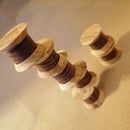Introduction: Carve an Cast Chocolate Treets
I think the best way to explain how this project came about is by saying a few things bumped into each other happily this happened... Firstly I have been doing a bunch of carvings recently and enjoying every second of it. Secondly a friend of mine told me about siligum and wouldn't shut up about how awesome it is for making food safe fabtastic moulds for casting assorts (she is a prop maker for TV so was actively casting puppet eyeballs with it) and i am planning to get married so I'm currently developing ideas for things like ladies favor's and wedding cakes which will blow people away with how awesome they are.
So being that I already had a few great things that I had made around to make molds of I decided to experiment.
~I bought a pretty reasonably priced pack of Silicone Moulding Paste and chocolate and set off on a bit of an experimenting adventure.
I have made moulds before but these tend to be in rubbers and algenate ect.. This was my first experience with siligum after researching it and its properties. I would defiantly recommend it as one of the easiest and quickest ways to make a mould there are.
Step 1: Grab the Thing You Want to Mould and the Siligum
I am lucky enough to have a few projects about the place at the moment.
If you would like to see how i made them follow these handy dandy links
https://www.instructables.com/id/Wooden-skull/
https://www.instructables.com/id/Easter-Tiki-egg/
https://www.instructables.com/id/Faciliers-Talisman...
I started with 300g of siligum and used about 2/3 of this amount making 3 castings
Step 2: Measure and Mix
The Silicone Moulding Paste I used asked for a 50/50 ratio of the blue and white.
Mix the two equal parts together until you have a solid tone with no streaks.
Step 3: Squish the Siligum Onto the Thing You Want to Make Copies of
When you have a constant consistency squish the silicone molding paste onto the surface you want to cast.
Plan ahead to avoid capturing air bubbles (if you do get air bubbles its not the end of the world but it does add another step a little down the line.)
If you only want to cast one side of the object like I have here with the talisman this is by far the easiest mould you can make and use. If like me you want to make things difficult for yourself then well done.. multi part moulds are seen as difficult. (they don't have to be really)
The moulds should set in five minutes.. (check your how to use guides)
Step 4: Re Enforce Your Moulds
OK so this is only needed for the 2 part mould makers. 1 part people you can skip a few steps.
I chose to re enforce my moulds with masking tape, (when making big moulds I tend to re enforce with plaster an more ridged forms but I thought with such small items masking tape would be sufficient.)
I taped each side leaving a line which would allow me to easily cut.
If I was to do this project I would place this seam line in a different place on the skull. (I don't think it adds anything good having a visible seam running though his face)
Step 5: Separate the Mould Halves
Make an incision into the mould stopping when you feel the solid wood and cut around the form.
Pull the two halves away from each other (you can put the carvings back where they came from now)
Step 6: If You Have Any Bubbles Fill Them
If you have any bubbles or imperfections mix some new siligum an fill the holes.
Step 7: Melt the Delicious Chocolate
There are a few good ways to melt chocolate. My preferred way involves eating it.
The best ways don,t heat the chocolate up too much and fully avoid burning the chocolate.
The method I used involves barely bringing a shallow pan of water to simmering temperature and resting a cereal or mixing bowl on the rim of this pan (at no point should the water touch the bowl). This will allow a controllable low heat to melt the chocolate.. Keep the chocolate moving and you should be rewarded with some perfectly melted chocolaty goodness. (try not to eat it all before making your chocolate castings)
There are a number of different types of chocolates which all have different properties. Here I was using a fairly cheep milk chocolate. Dark chocolate would have made my house smell amazing.
Step 8: Poor the Molten Chocolate Into the Moulds
Poor the molten chocolate into the moulds.
Carefully re-line your 2 part moulds and allow them to cure.
Here is where you can make a decisions about how you want your chocolate to act... (its characteristics as chocolate) If you put it in the fridge to cure you will end up with soft chocolate which is more likley to react with the air and "bloom", If you allow it to cool more slowly it will create a harder chocolate and will look better. I have heard that the ideal temperature for chocolate to form is the same temperature found inside of a wine fridge (around where the red wine would be kept)
Step 9: Open Up the Moulds and Enjoy
Open up the moulds and enjoy.
You might want to crank it up a notch by using food paint or decoration. These chocolaty loveys did not last long enough to be painted or decorated. Though I did have plans to use edible gold leaf on the skull.

Participated in the
Snack Contest













